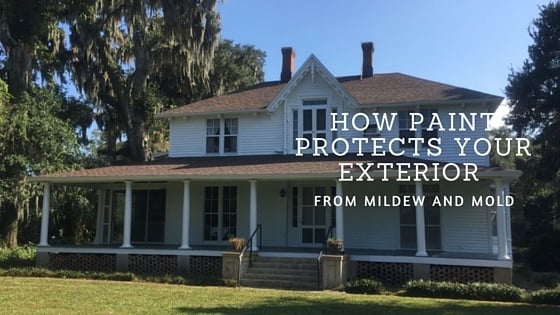Mildew and mold are two persistent problems in hot and humid climates. Additionally, they’re two of the reasons why homeowners decide to repaint their exterior surfaces. Though many people assume that a new coat of paint will solve mildew and mold problems, it won’t. That’s because paint cannot kill mold spores or prevent them from spreading.
 To get rid of mold problems, you need to treat the areas affected with a bleach-based or TSP-bleach solution, scrub the surface using a soft brush and rinse thoroughly to remove any residue left behind. Besides cleaning the exterior surfaces properly, it’s critical to select a good quality paint formulated with mildewcides. Here is how a specialty paint system can protect your exterior surfaces from mildew and mold.
To get rid of mold problems, you need to treat the areas affected with a bleach-based or TSP-bleach solution, scrub the surface using a soft brush and rinse thoroughly to remove any residue left behind. Besides cleaning the exterior surfaces properly, it’s critical to select a good quality paint formulated with mildewcides. Here is how a specialty paint system can protect your exterior surfaces from mildew and mold.
- Paint can prevent deterioration. Painting directly over mold or over surfaces that still present traces of mildew or mold will make the problem worse. The existing spores will immediately infect the new paint film, continuing to grow under it and eating away at different structures in your home. Mold spores feeding on wall materials will let moisture and water get into the wall system. This can lead to serious structural damage. As an example, moisture can encourage dry rot fungi to grow and spread into the wood, which will negatively affect the strength and structural integrity of the wood framing. Therefore, preparing exterior surfaces correctly and applying the right paint can help prevent the deterioration of the entire wall system.
- Paint protects exterior surfaces only for a certain period of time. The mold inhibitors used to formulate anti-mold paint work by penetrating the spores and disrupting their functions. The spores are no longer able to grow or reproduce. But when exposed to UV radiation, moisture and rainwater, anti-mold coatings deteriorate just as any other type of paint. Once paint deterioration occurs, hairline cracks and small holes will start to develop in the paint film, providing favorable conditions for mildew and mold to grow. To prevent mildew and mold along with extensive damage, it’s important to deal with the first signs of deterioration before paint failure becomes severe.
- Specialty coating systems can keep exterior surfaces mildew- and mold-free. Today, you can find a wide variety of mold-resistant coatings. But some exterior paint products have been specifically formulated to be mildew- and mold-proof. While the regular anti-mold paint can protect wall surfaces from mold, mold-proof coatings prevent mildew and mold from growing on the paint film.
Here are a few valuable takeaways you should consider:
- Use anti-mold paint with caution, as it’s toxic to people and pets.
- When applying paint that contains mildewcides, wear a mask, safety glasses and gloves.
- Prepare and paint exterior surfaces on a calm day to prevent mold spores from spreading to other areas.
- Most flat paints and paints formulated with linseed oil are susceptible to mildew and mold. Don’t use these products in areas previously affected by mold.
- Pressure washing and repainting exterior surfaces regularly will prevent mold from growing.
- Pruning trees and shrubs every year will improve outdoor ventilation. This will prevent mildew and mold from growing inside wall corners, under eaves, on your porch ceiling, etc.
- Completely removing mold from porous surfaces like wood is almost impossible for a regular DIYer. For this reason, we recommend calling in professional painting contractors who can take care of the problem for you.
If you’ve got a mildew or mold problem you need help with, we suggest scheduling a free consultation with our experienced paint contractors. One of our professionals will come to your home, assess the situation and make all the recommendations necessary. If you decide to hire us, our painting crew will deliver a high-quality paint job that will allow you to enjoy newly painted, mold-free exterior surfaces for many years to come.






